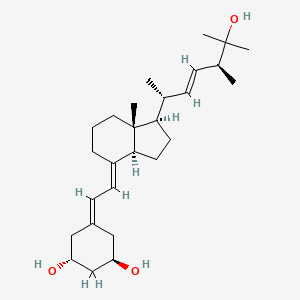D1038 | paricalcitol
H
H05BX02 Paricalcitol
[H05BX] Other anti-parathyroid agents
[H05B] ANTI-PARATHYROID AGENTS
[H05] CALCIUM HOMEOSTASIS
[H] Systemic hormonal preparations, excluding reproductive hormones and insulins
| Toxicity | Dose | Time | Species | Model | Method | Action | Positive criterion | Reference |
|---|---|---|---|---|---|---|---|---|
| MEMBRANE POTENTIAL | 8.91±1.56 | human | qHTS-HepG2 | MMP assay | decrease | IC50 | 163 | |
| MEMBRANE POTENTIAL | human | HepG2 | MMP assay | Negative | IC50 | 163 | ||
| MEMBRANE POTENTIAL | rat | hepatocytes | MMP assay | Negative | IC50 | 163 | ||
| Pictogram | Signal | Statements | Precautionary Statement Codes |
|---|---|---|---|
  |
Danger |
Aggregated GHS information provided by 140 companies from 5 notifications to the ECHA C&L Inventory. Each notification may be associated with multiple companies. H300 (72.86%): Fatal if swallowed [Danger Acute toxicity, oral] H301+H311 (27.14%): Toxic if swallowed or in contact with skin [Danger Acute toxicity, oral acute toxicity, dermal] H301 (27.14%): Toxic if swallowed [Danger Acute toxicity, oral] H311 (98.57%): Toxic in contact with skin [Danger Acute toxicity, dermal] H330 (27.14%): Fatal if inhaled [Danger Acute toxicity, inhalation] H351 (68.57%): Suspected of causing cancer [Warning Carcinogenicity] H361 (72.86%): Suspected of damaging fertility or the unborn child [Warning Reproductive toxicity] H362 (67.14%): May cause harm to breast-fed children [Reproductive toxicity, effects on or via lactation] H372 (27.14%): Causes damage to organs through prolonged or repeated exposure [Danger Specific target organ toxicity, repeated exposure] Information may vary between notifications depending on impurities, additives, and other factors. The percentage value in parenthesis indicates the notified classification ratio from companies that provide hazard codes. Only hazard codes with percentage values above 10% are shown. |
P201, P202, P260, P263, P264, P270, P271, P280, P281, P284, P301+P310, P302+P352, P304+P340, P308+P313, P310, P312, P314, P320, P321, P322, P330, P361, P363, P403+P233, P405, and P501; (The corresponding statement to each P-code can be found at the GHS Classification page.) |
| (1R,3R)-5-(2-((1R,3aS,7aR,E)-1-((2R,5S,E)-6-hydroxy-5,6-dimethylhept-3-en-2-yl)-7a-methyloctahydro-4H-inden-4-ylidene)ethylidene)cyclohexane-1,3-diol | (1R,3R)-5-[(2E)-2-[(1R,3aS,7aR)-1-[(E,2R,5S)-6-hydroxy-5,6-dimethylhept-3-en-2-yl]-7a-methyl-2,3,3a,5,6,7-hexahydro-1H-inden-4-ylidene]ethylidene]cyclohexane-1,3-diol | (1R,3R,5Z)-5-[(2E)-2-[(1R,3aS,7aR)-octahydro-1-[(1R,2E,4S)-5-hydroxy-1,4,5-trimethyl-2-hexen-1-yl]-7a-methyl-4H-inden-4-ylidene]ethylidene]-1,3-cyclohexanediol |
| (1R,3R,7E)-17beta-[(2R,3E,5S)-6-hydroxy-5,6-dimethylhept-3-en-2-yl]-9,10-secoestra-5,7-diene-1,3-diol | (1alpha.3beta,7E,22E)-19-Nor-9,10-secoergosta-5,7,22-triene-1,3,25-triol | (7E,22E)-19-Nor-9,10-secoergosta-5,7,22-triene-1alpha,3beta,25-triol |
| 1,3-Cyclohexanediol, 5-[(2E)-2-[(1R,3aS,7aR)-octahydro-1-[(1R,2E,4S)-5-hydroxy-1,4,5-trimethyl-2-hexen-1-yl]-7a-methyl-4H-inden-4-ylidene]ethylidene]-, (1R,3R,5Z)-; | 131918-61-1 | 19-Nor-1,25-(OH)2D2 |
| 19-Nor-1,25-dihydroxyvitamin D2 | 19-Nor-1-alpha,25-dihydroxyvitamin D2 | 19-Nor-1alpha,25-dihydroxyvitamin D2 |
| 19-Nor-9,10-secoergosta-5,7,22-triene-1,3,25-triol, (1alpha,3beta,7E,22E)- | 19-Nor-9,10-secoergosta-5,7,22-triene-1,3,25-triol,(1alpha,3beta,7E,22E) | 6702D36OG5 |
| 918P611 | ABT-358 | ACT07192 |
| AKOS005145562 | Ab 122358 | BCP9001050 |
| BDBM233195 | BIDD:GT0330 | BPKAHTKRCLCHEA-UBFJEZKGSA-N |
| C08127 | CAS-131918-61-1 | CHEBI:7931 |
| CHEMBL1200622 | CS-0705 | Compound 49510 |
| Compound-49510 | D00930 | DB00910 |
| DSSTox_CID_28566 | DSSTox_GSID_48640 | DSSTox_RID_82838 |
| DTXSID4048640 | GTPL2791 | HSDB 7360 |
| HY-50919 | LMST04030163 | LS-172812 |
| NCGC00182706-01 | Paracalcin | Paricalcitol |
| Paricalcitol (JAN/USAN/INN) | Paricalcitol [USAN:USP:INN] | Paricalcitol [USAN] |
| Paricalcitol, 19-nor-(OH)2-vitD2, paracalcin | PubChem18825 | Q155746 |
| SC-20905 | SCHEMBL3655 | Tox21_112987 |
| UNII-6702D36OG5 | W-5365 | ZINC13911941 |
| Zemplar | Zemplar (TN) |

